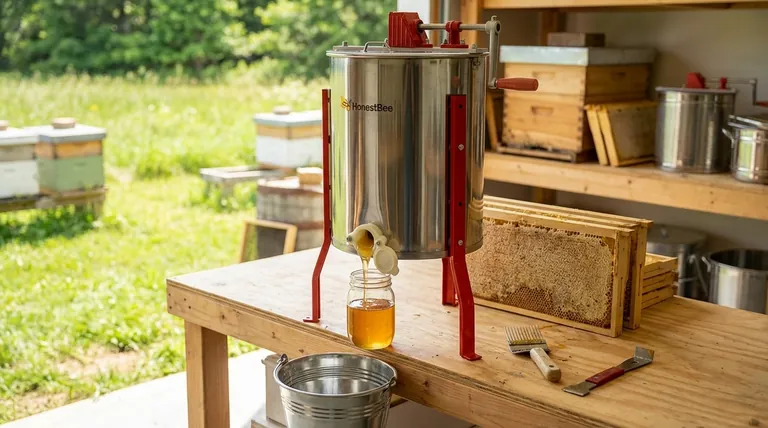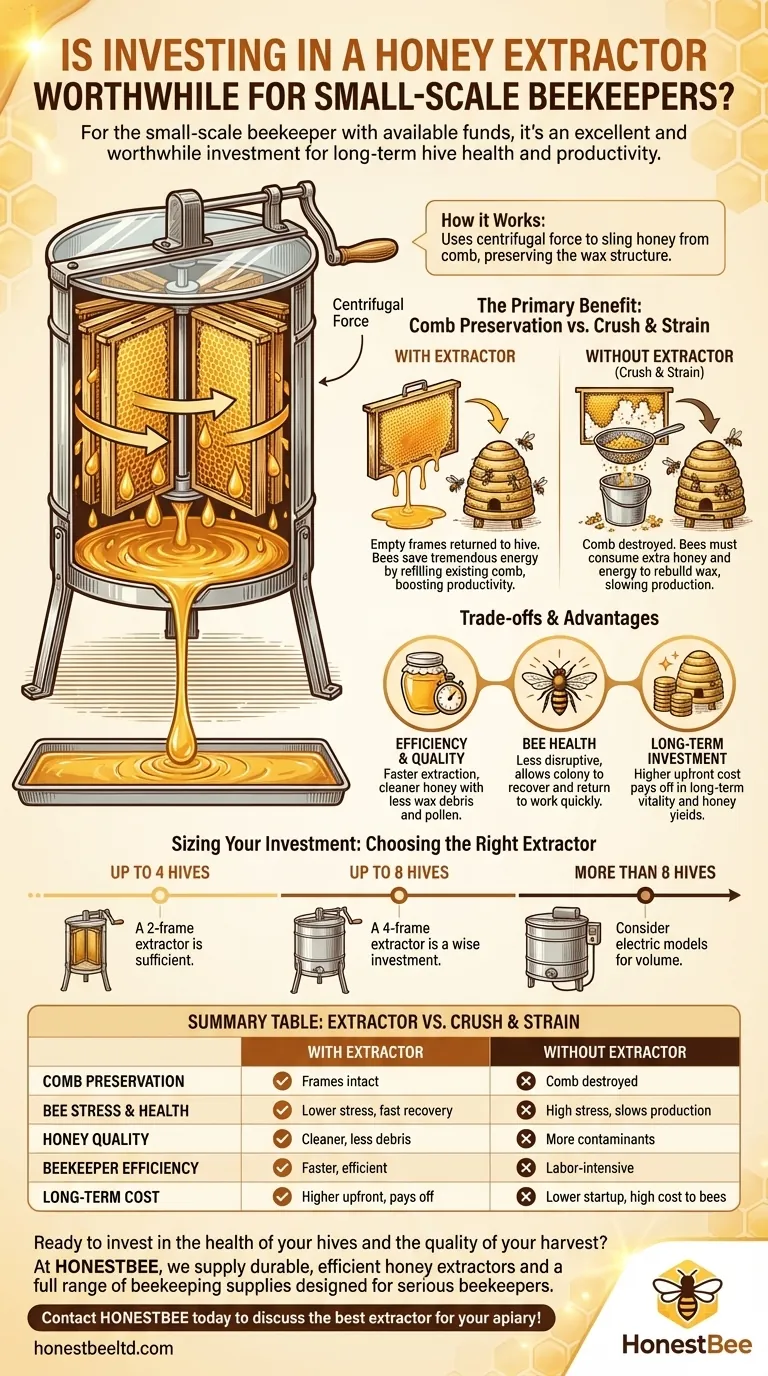For the small-scale beekeeper with available funds, a honey extractor is an excellent and worthwhile investment. While not strictly necessary for your first harvest, it represents a significant upgrade in efficiency, honey quality, and, most importantly, the long-term health and productivity of your bees. For any beekeeper planning to manage more than one or two hives, it quickly becomes an essential tool.
The decision to buy a honey extractor is less about the immediate cost and more about your beekeeping philosophy. It marks a shift from simply harvesting honey to actively investing in the energy and resources of your bee colonies for future success.

How a Honey Extractor Changes Your Harvest
A honey extractor is a specialized centrifuge designed for a single purpose: to remove honey from the comb without destroying it. Understanding this core function is key to appreciating its value.
The Principle of Centrifugal Force
An extractor is a large drum with an internal basket designed to hold honey frames. By spinning this basket, either with a manual crank or an electric motor, the device uses centrifugal force to sling the honey out of the wax cells and onto the drum's inner wall, where it pools at the bottom for collection.
The Primary Benefit: Preserving the Comb
The single greatest advantage of using an extractor is the preservation of the drawn-out honeycomb. Bees expend a tremendous amount of energy and resources to produce wax and build these intricate structures.
By keeping the comb intact, you can return the empty frames directly to the hive. The bees can then immediately begin cleaning them and refilling them with new honey, saving them the exhaustive work of rebuilding from scratch.
Efficiency and a Cleaner Product
For the beekeeper, the process is far more efficient than manual methods. Extraction is faster and produces a higher quality final product with significantly less wax debris, pollen, and other hive particles that must be filtered out. This reduces processing time and results in purer honey.
Understanding the Trade-offs
The primary alternative to an extractor is the "crush and strain" method. This involves cutting the comb from the frame, crushing it to release the honey, and straining the mixture through a filter. The choice between these two approaches involves clear trade-offs.
Initial Cost vs. Ongoing Bee Labor
The most obvious drawback of an extractor is its upfront financial cost. The crush and strain method, by contrast, requires minimal equipment.
However, the "cost" of the crush and strain method is paid entirely by your bees. By destroying their comb, you force them to consume significant amounts of honey (their energy source) just to produce the wax needed to rebuild. This can slow the colony's overall honey production for the season.
Reduced Stress on the Colony
An extractor is a far less disruptive tool. You can uncap the frames, extract the honey, and return the empty combs to the hive in a relatively short period. This allows the colony to recover quickly and get back to work.
Sizing Your Investment
The size of the extractor should be based on the number of hives you manage. A small operation can function perfectly well with a manual, two-frame model.
A general rule of thumb is to scale your extractor's capacity with your apiary:
- Up to 4 hives: A 2-frame extractor is sufficient.
- Up to 8 hives: A 4-frame extractor is a wise investment.
- More than 8 hives: Consider larger 8-frame or 16-frame models, likely electric, to handle the volume.
Making the Right Choice for Your Goal
Your decision ultimately depends on your primary focus as a beekeeper.
- If your primary focus is the lowest possible startup cost: Begin with the crush and strain method for your first one or two harvests, but plan to upgrade as you grow.
- If your primary focus is bee health and long-term productivity: An extractor is the superior choice, as it conserves your bees' most valuable resources: time and energy.
- If your primary focus is growing your apiary beyond a few hives: A honey extractor is an essential and non-negotiable tool for efficient and sustainable honey processing.
Investing in an extractor is an investment in the long-term vitality and productivity of your hives.
Summary Table:
| Factor | With Extractor | Without Extractor (Crush & Strain) |
|---|---|---|
| Comb Preservation | Frames are returned intact, saving bees energy. | Comb is destroyed, forcing bees to rebuild. |
| Bee Stress & Health | Lower stress; colony recovers quickly. | High stress; slows colony's honey production. |
| Honey Quality | Cleaner honey with less wax and debris. | More contaminants require extensive filtering. |
| Beekeeper Efficiency | Faster, more efficient harvesting process. | Labor-intensive and time-consuming method. |
| Long-Term Cost | Higher upfront cost, but pays off in hive productivity. | Lower startup cost, but higher long-term cost to the bees. |
Ready to invest in the health of your hives and the quality of your harvest?
For small-scale beekeepers planning to grow, a honey extractor is a crucial tool for sustainable beekeeping. At HONESTBEE, we supply durable, efficient honey extractors and a full range of beekeeping supplies designed for the needs of serious beekeepers.
Let us help you choose the right equipment to maximize your honey yields and support your colony's long-term health.
Contact HONESTBEE today to discuss the best extractor for your apiary!
Visual Guide

Related Products
- 2 Frame Stainless Steel Manual Honey Spinner Extractor for Beekeeping
- 6 Frame Manual Stainless Steel Honey Extractor Beekeeping Equipment
- Plastic Hand Crank 2 Frame Honey Extractor Low Price
- HONESTBEE 72 Frame Industrial Electric Honey Extractor for Beekeeping
- electric honey extractor honey centrifuge 3 frame honey extractor stainless steel honey frame extractor
People Also Ask
- How does centrifugation work in honey extraction? The Sustainable Method for Modern Beekeepers
- Can a manual extractor be upgraded to an electric one? Save Labor & Boost Efficiency
- How can a pressure washer be used to clean a honey extractor? A Guide to Safe and Efficient Cleaning
- What are some expert tips for cleaning a honey extractor? Protect Your Harvest & Equipment
- How often should a honey extractor be cleaned if used multiple times a year? Optimize Your Harvest Workflow



















